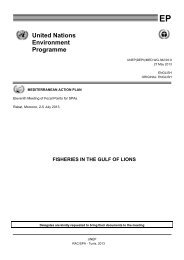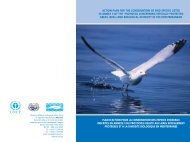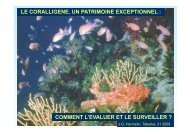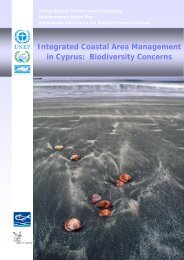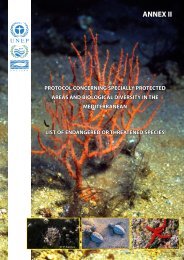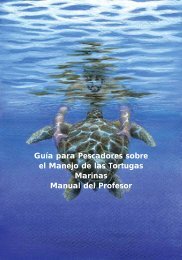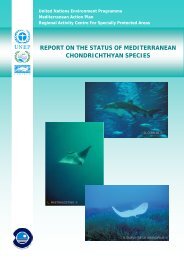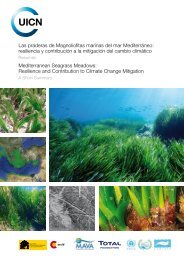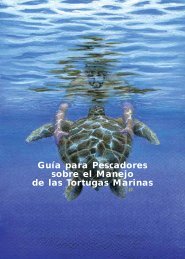Proceedings of the Second Mediterranean Symposium on Marine
Proceedings of the Second Mediterranean Symposium on Marine
Proceedings of the Second Mediterranean Symposium on Marine
You also want an ePaper? Increase the reach of your titles
YUMPU automatically turns print PDFs into web optimized ePapers that Google loves.
PROCEEDINGS OF THE SECOND MEDITERRANEAN SYMPOSIUM ON MARINE VEGETATION (ATHENS, 12-13 DECEMBER 2003)<br />
44<br />
In <str<strong>on</strong>g>the</str<strong>on</strong>g> same way, Caulerpa prolifera (Chlorobi<strong>on</strong>ta, Viridobi<strong>on</strong>ta, Plantae), which moves<br />
northwards from <str<strong>on</strong>g>the</str<strong>on</strong>g> central and sou<str<strong>on</strong>g>the</str<strong>on</strong>g>rn <str<strong>on</strong>g>Mediterranean</str<strong>on</strong>g> during warm climatic episodes,<br />
<str<strong>on</strong>g>the</str<strong>on</strong>g>n southwards during cold episodes, is not an introduced species in <str<strong>on</strong>g>the</str<strong>on</strong>g> north-western<br />
Med-iterranean (e.g. <str<strong>on</strong>g>the</str<strong>on</strong>g> Gulf <str<strong>on</strong>g>of</str<strong>on</strong>g> Marseilles), where it occurs nowadays (Marc Verlaque,<br />
unpublished data).<br />
Fig. 7. Change over time (every 20 years, 1880 through 2000) in <str<strong>on</strong>g>the</str<strong>on</strong>g><br />
cumulative number <str<strong>on</strong>g>of</str<strong>on</strong>g> likely introduced macrophytes in <str<strong>on</strong>g>the</str<strong>on</strong>g> <str<strong>on</strong>g>Mediterranean</str<strong>on</strong>g><br />
Sea. From Boudouresque (1999a) and Boudouresque and<br />
Verlaque (2002), up-dated.<br />
Since <str<strong>on</strong>g>the</str<strong>on</strong>g> early 20 th century, <str<strong>on</strong>g>the</str<strong>on</strong>g> number <str<strong>on</strong>g>of</str<strong>on</strong>g> species probably<br />
introduced into <str<strong>on</strong>g>the</str<strong>on</strong>g> <str<strong>on</strong>g>Mediterranean</str<strong>on</strong>g> has more or less<br />
doubled every 20 years (Fig. 7; Boudouresque, 1999a;<br />
Boudouresque and Verlaque, 2002). To date, a hundred <str<strong>on</strong>g>of</str<strong>on</strong>g><br />
macrophytes have probably been introduced into <str<strong>on</strong>g>the</str<strong>on</strong>g><br />
<str<strong>on</strong>g>Mediterranean</str<strong>on</strong>g>. They represent 6.5% <str<strong>on</strong>g>of</str<strong>on</strong>g> its known flora. For<br />
comparative purposes, <str<strong>on</strong>g>the</str<strong>on</strong>g>re are <strong>on</strong>ly 37 al<strong>on</strong>g <str<strong>on</strong>g>the</str<strong>on</strong>g><br />
European and nor<str<strong>on</strong>g>the</str<strong>on</strong>g>rn Africa Atlantic coasts (from Canary<br />
Islands to Scandinavia and <str<strong>on</strong>g>the</str<strong>on</strong>g> Baltic Sea). The <str<strong>on</strong>g>Mediterranean</str<strong>on</strong>g><br />
Sea is <str<strong>on</strong>g>the</str<strong>on</strong>g>refore a major hot spot for introduced species.<br />
The main vectors <str<strong>on</strong>g>of</str<strong>on</strong>g> introducti<strong>on</strong> are shellfish aquaculture, fouling <strong>on</strong> ship hulls and<br />
<str<strong>on</strong>g>the</str<strong>on</strong>g> Suez Canal (Bou-dou-resque, 1999a, 1999b; Boudouresque and Verlaque,<br />
2002). After habitat destructi<strong>on</strong>, introduced species are <str<strong>on</strong>g>the</str<strong>on</strong>g> sec<strong>on</strong>d greatest cause <str<strong>on</strong>g>of</str<strong>on</strong>g><br />
species endangerment and decline worldwide (Schmitz and Simberl<str<strong>on</strong>g>of</str<strong>on</strong>g>f, 1997).<br />
However, each introduced species c<strong>on</strong>stitutes a special case (Carlt<strong>on</strong> and Geller,<br />
1993). According to species, <str<strong>on</strong>g>the</str<strong>on</strong>g> following has been observed (Boudouresque,<br />
1999a): (i) Zero to slight impact. (ii) More or less drastic change in <str<strong>on</strong>g>the</str<strong>on</strong>g> number<br />
and/or abundance <str<strong>on</strong>g>of</str<strong>on</strong>g> native species (e.g. in macrophyte communities invaded by<br />
Caulerpa taxifolia). (iii) Displacement <str<strong>on</strong>g>of</str<strong>on</strong>g> species occupying a close ecological niche.<br />
(iv) Change in <str<strong>on</strong>g>the</str<strong>on</strong>g> functi<strong>on</strong>ing <str<strong>on</strong>g>of</str<strong>on</strong>g> native ecosystems, due to an introduced species<br />
which acts as a keys-pecies (Fig. 8-10). (v) Displacement <str<strong>on</strong>g>of</str<strong>on</strong>g> native ecosystems, due<br />
to <str<strong>on</strong>g>the</str<strong>on</strong>g> setting up <str<strong>on</strong>g>of</str<strong>on</strong>g> a totally new ecosystem. This is <str<strong>on</strong>g>the</str<strong>on</strong>g> case with Caulerpa taxifolia,<br />
which c<strong>on</strong>stitutes a meadow displacing several native ecosystems (e.g. <str<strong>on</strong>g>the</str<strong>on</strong>g> Cystoseira<br />
brachycarpa forest, <str<strong>on</strong>g>the</str<strong>on</strong>g> Padina pav<strong>on</strong>ica and Halopteris scoparia community, <str<strong>on</strong>g>the</str<strong>on</strong>g><br />
Posid<strong>on</strong>ia oceanica dead matte community, several sand bottom communities and<br />
<str<strong>on</strong>g>the</str<strong>on</strong>g> coralligenous community) and homogenizing habitats and <str<strong>on</strong>g>the</str<strong>on</strong>g> landscape<br />
(Fig. 11). Within a given habitat, alpha species diversity can increase (e.g. sand<br />
bottoms and <str<strong>on</strong>g>the</str<strong>on</strong>g> Cymodocea nodosa meadow) or decrease (e.g. <str<strong>on</strong>g>the</str<strong>on</strong>g> Posid<strong>on</strong>ia<br />
oceanica meadow and Cystoseira forests) (Verlaque and Fritayre, 1994; Verlaque<br />
and Boudouresque, 1995; Harmelin-Vivien et al., 1999). However, at regi<strong>on</strong> scale,<br />
gamma species diversity always decreases (Fig. 11). Synergy between several




